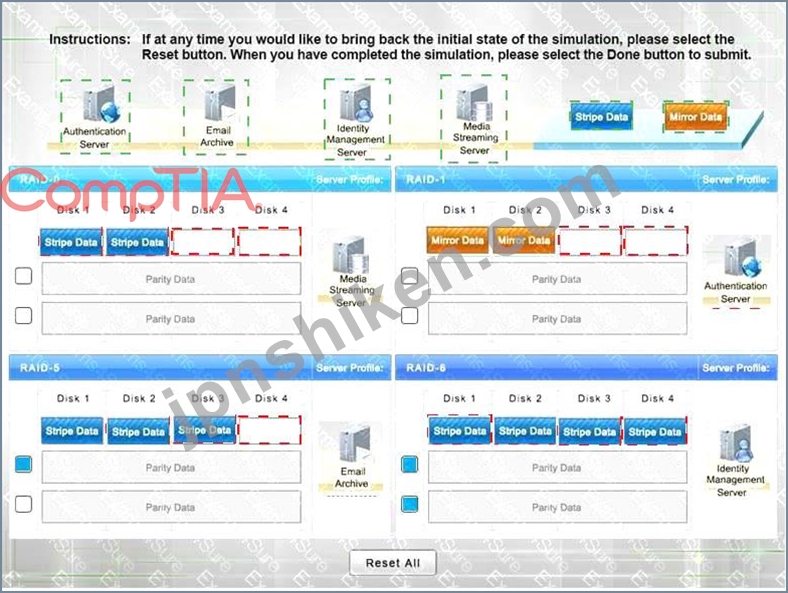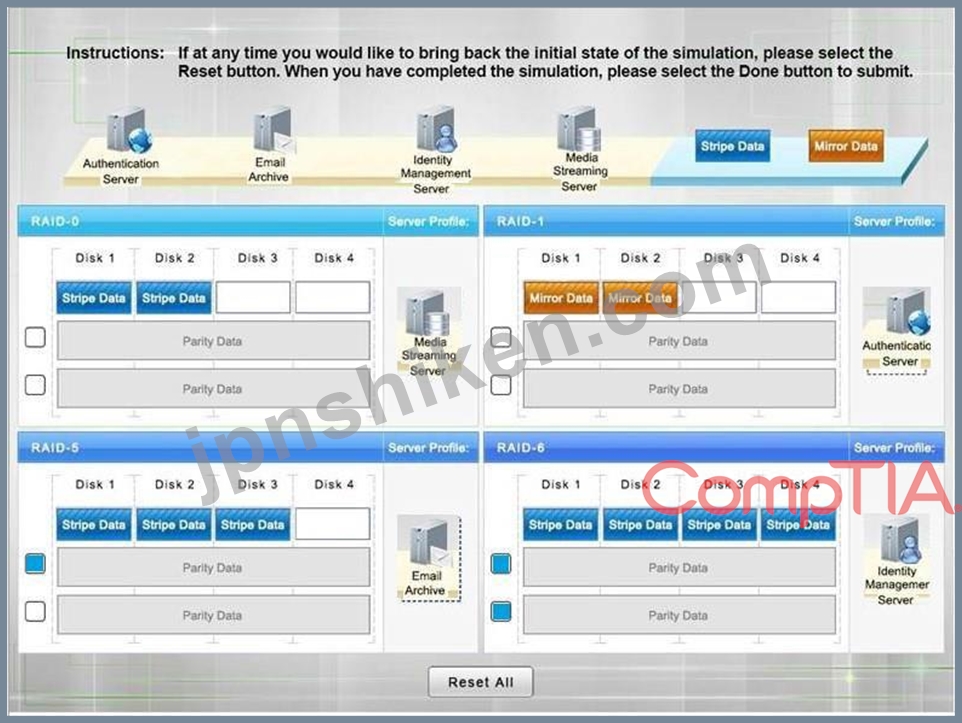- ホーム
- CompTIA
- SY0-501-JPN - CompTIA Security+ Certification Exam (SY0-501日本語版)
- CompTIA.SY0-501-JPN.v2019-11-12.q242
- 質問169
有効的なSY0-501-JPN問題集はJPNTest.com提供され、SY0-501-JPN試験に合格することに役に立ちます!JPNTest.comは今最新SY0-501-JPN試験問題集を提供します。JPNTest.com SY0-501-JPN試験問題集はもう更新されました。ここでSY0-501-JPN問題集のテストエンジンを手に入れます。
SY0-501-JPN問題集最新版のアクセス
「715問、30% ディスカウント、特別な割引コード:JPNshiken」
セキュリティ管理者には、展開されているサーバーのセキュリティと可用性のプロファイルが与えられます。
*各RAIDタイプを、正しい構成と最小数のドライブと一致させます。
*サーバーのプロファイルを確認し、整合性、可用性、I / O、ストレージの要件に基づいて、適切なRAIDタイプに一致させます。指示:
*すべてのドライブ定義を必要なだけ何度でもドラッグできます
*すべてのプレースホルダがRAID構成ボックスに入っているわけではありません
*パリティが必要な場合は、パリティチェックボックスの適切な数を選択してください
*サーバープロファイルは1回だけドラッグすることができます
シミュレーションの初期状態をいつでも元に戻したい場合は、リセットボタンを選択してください。
シミュレーションが完了したら、完了ボタンを選択して提出してください。シミュレーションが提出されたら、[次へ]ボタンを選択して続行してください。

*各RAIDタイプを、正しい構成と最小数のドライブと一致させます。
*サーバーのプロファイルを確認し、整合性、可用性、I / O、ストレージの要件に基づいて、適切なRAIDタイプに一致させます。指示:
*すべてのドライブ定義を必要なだけ何度でもドラッグできます
*すべてのプレースホルダがRAID構成ボックスに入っているわけではありません
*パリティが必要な場合は、パリティチェックボックスの適切な数を選択してください
*サーバープロファイルは1回だけドラッグすることができます
シミュレーションの初期状態をいつでも元に戻したい場合は、リセットボタンを選択してください。
シミュレーションが完了したら、完了ボタンを選択して提出してください。シミュレーションが提出されたら、[次へ]ボタンを選択して続行してください。

正解:

Explanation

RAID-0 is known as striping. It is not a fault tolerant solution but does improve disk performance for read/write operations. Striping requires a minimum of two disks and does not use parity.
RAID-0 can be used where performance is required over fault tolerance, such as a media streaming server.
RAID-1 is known as mirroring because the same data is written to two disks so that the two disks have identical data. This is a fault tolerant solution that halves the storage space. A minimum of two disks are used in mirroring and does not use parity. RAID-1 can be used where fault tolerance is required over performance, such as on an authentication server. RAID-5 is a fault tolerant solution that uses parity and striping. A minimum of three disks are required for RAID-5 with one disk's worth of space being used for parity information. However, the parity information is distributed across all the disks. RAID-5 can recover from a sing disk failure.
RAID-6 is a fault tolerant solution that uses dual parity and striping. A minimum of four disks are required for RAID-6. Dual parity allows RAID-6 to recover from the simultaneous failure of up to two disks. Critical data should be stored on a RAID-6 system.
http://www.adaptec.com/en-us/solutions/raid_levels.html
- 質問一覧「242問」
- 質問1 セキュリティアナリストが、ソフトウェアのバージョン、実行中の
- 質問2 製造組織の副社長は、デスクトップがネットワークに接続されてい
- 質問3 ネットワーク管理者は、ウェブインターフェースを介してブルート
- 質問4 セキュリティ管理者は、組織の物理アクセス制御システム(PACS)...
- 質問5 ネットワーク上のいくつかのワークステーションは、特定の攻撃に
- 質問6 Annは、システムのデータの分類が決定されているいくつかの新し...
- 質問7 セキュリティ監査人は、大規模なサービスプロバイダーの非常に忙
- 質問8 セキュリティエンジニアは、ユーザーが資格情報を提供する前に、
- 質問9 必須のアクセス制御環境で設定を構成する場合、次のうち特定のデ
- 質問10 最近の内部監査では、社内の各部署のVMがインストールされている...
- 質問11 システム管理者がファイルシステムのルートで疑わしいファイルを
- 質問12 次のうちどれがセキュリティ上の欠陥について監査人がプロプライ
- 質問13 小規模オフィスのネットワーク管理者は、暗号化されたワイヤレス
- 質問14 監査では、データベース管理者がデータベースの変更とバックアッ
- 質問15 規制要件により、セキュリティアナリストはWindowsファイルサー...
- 質問16 ファイアウォール管理者は、会社のリモートアクセスソリューショ
- 質問17 従業員はRDPを使用してオフィスネットワークに接続し直します。 ...
- 質問18 次の暗号アルゴリズムのどれが固定長の不可逆出力を生成しますか
- 質問19 特定されたセキュリティ侵害の後、アナリストはIRプロセスを開始...
- 質問20 組織は、企業ネットワークアーキテクチャ内で多要素認証技術を実
- 質問21 財務部門の従業員に電子メールで送信された添付ファイルには、埋
- 質問22 会社のユーザーロックアウトポリシーは、5回のログイン試行の失
- 質問23 法医学専門家は犯罪現場からハードドライブを与えられ、調査を実
- 質問24 セキュリティアナリストがサーバー上のパッチを確認しています。
- 質問25 非常に複雑なパスワードポリシーにより、アカウントパスワードを
- 質問26 データ漏洩事件への対応が成功した後、インシデントチームのリー
- 質問27 大規模な防衛契約会社の最高経営責任者(CEO)は、海外で会議を...
- 質問28 組織の従業員は現在、複数の内部リソースにアクセスするために3
- 質問29 セキュリティアナリストがクライアントの安全なネットワークに侵
- 質問30 データの暗号化に関しては、パスワードデータをストレージに無作
- 質問31 ポータブルデータ記憶装置は、悪意のあるファームウェアを有する
- 質問32 監査人は、次のものを表示するツールを実行して、組織のセキュリ
- 質問33 ヘルプデスクは、会計部門のユーザーから多数のパスワード変更ア
- 質問34 各項目に対して、ドロップダウンの選択肢から適切な認証カテゴリ
- 質問35 システムの可用性には最高の優先度が付けられています。目的を確
- 質問36 次のうちどれが予防と修正の論理的制御を同時に表すセキュリティ
- 質問37 ある株取引会社は、承認されたセカンダリデータセンターを強化す
- 質問38 会社Aは、会社Bの測定可能な目標を使用して境界保護、電力、およ...
- 質問39 情報セキュリティアナリストは、特定のシステムのデータがビジネ
- 質問40 ネットワーク管理者は、内部ルーティングを確保する方法を実装し
- 質問41 モバイルワークステーションを保護しようとするとき、次の認証技
- 質問42 情報セキュリティの専門家が、Linuxサーバーからの次の出力を検...
- 質問43 組織は、ネットワークリソースへの従業員のアクセスにSSO認証を...
- 質問44 CIO(最高情報責任者)は、1年に数回コンピューティング利用率が...
- 質問45 複数の従業員は、開かれたときに、ハードドライブとマップされた
- 質問46 IPアドレスが204.211.38.211/24の従業員ワークステーションは、...
- 質問47 法律事務所は、リモートオフィスを本社に接続するために、地元の
- 質問48 秘密でないスキャンではなく、システムに対して秘密であるスキャ
- 質問49 次のネットワーク脆弱性スキャンインジケータのどれが成功したア
- 質問50 受信したメッセージがデマであるという最高の指標の中で、次のう
- 質問51 次のうちSAMLを使用するテクノロジはどれですか? (2つ選択して...
- 質問52 セキュリティ管理者が、SMBプロトコルの古いリモートの脆弱性を...
- 質問53 次のうち、サーバーにルートキットをインストールする前の攻撃の
- 質問54 PKIが安全に鍵を投影するために通常使用する暗号化方式はどれで...
- 質問55 企業は最近、企業ネットワークを介したデータの流出を経験しまし
- 質問56 アプリケーション開発者は、あるサービスから別のサービスへの安
- 質問57 無線ネットワークには、次の設計要件があります。 * 認証はエン...
- 質問58 感染が検出される前に、感染したデバイスのいくつかは、会社名に
- 質問59 セキュリティアナリストは、疑わしいセキュリティ侵害を調査し、
- 質問60 セキュリティアナリストが潜在的な侵害を調査しています。 証拠
- 質問61 リモートユーザー(User1)は、新しくプロビジョニングされた企...
- 質問62 ワイヤレスネットワークは、オーセンティケータに接続されたRADI...
- 質問63 ある企業は、ドライブを再利用できないように、記憶媒体からの機
- 質問64 多くの従業員が、ERPアプリケーションの一部が機能していないと...
- 質問65 セキュリティアナリストは、脆弱性のネットワークトラフィックを
- 質問66 ネットワーク技術者は、進行中のネットワークベースの攻撃のソー
- 質問67 データセンターは最近違反を経験しました。アクセスが得られたと
- 質問68 銀行は、顧客が新しい口座を開設したいときに、窓口担当者にマネ
- 質問69 組織は、名前解決サービスのセキュリティを強化したいと考えてい
- 質問70 チーフ・セキュリティ・オフィサー(CS0)は、すべての内部Webサ...
- 質問71 マルチファンクションプリンタ向けのネットワーク攻撃によるリス
- 質問72 セキュリティアナリストは、IPSからの次の出力を検討しています...
- 質問73 ダンプスクエアダイバーは会社から複数のハードドライブを回復し
- 質問74 デスクトップシステムに対して脆弱性スキャンが行われています。
- 質問75 新入社員入社プロセスでは、次の項目が提示されます。 - ラップ...
- 質問76 Web開発者は、会社のREST APIへのクライアントアクセスを改善し...
- 質問77 セキュリティ管理者が、会社のネットワーク上にRADIUSとTACACS +...
- 質問78 会社は不正行為のために従業員を解雇しています。この従業員から
- 質問79 次のうちどれがシステムを動作状態に復元するために使用される用
- 質問80 次のどのような暗号化攻撃でパスワードのソルトが無効になるので
- 質問81 会社の新しい発券システムにログオンしようとすると、次のメッセ
- 質問82 インターネットを閲覧した後、ユーザーのJoeは目が覚めて彼のす...
- 質問83 社内の侵入テスト担当者が新しいDLPシステムを回避するよう求め...
- 質問84 セキュリティ管理者は、社内のファイアウォールインターフェイス
- 質問85 金曜日の午後に、あなたの組織の上司が降格されました。スーパー
- 質問86 セキュリティ管理者は、建物のフェンスラインの外に駐車する車に
- 質問87 次のうち、多要素認証とみなされるものはどれですか?
- 質問88 セキュリティエンジニアがパブリックWebサーバーにSSLを追加した...
- 質問89 管理者は、 "Bowman"という名前のネットワークファイルサーバー...
- 質問90 マネージャーは、データベースアクセスの高いIT従業員が、競合他...
- 質問91 ネットワーク管理者はACLを追加して、ホスト192.168.2.3からWeb...
- 質問92 次の脅威の俳優のうち、マーケットの優位性と市場投入までの時間
- 質問93 アナリストは、大規模な金融サービス組織で機密データの潜在的な
- 質問94 セキュリティ管理者のアン氏は、同社のアプリケーションについて
- 質問95 次のうち、サーバーデータミラーリングが有効になっていない場合
- 質問96 Joeは暗号化された電子メールを他の人と交換しています。 Joeは...
- 質問97 セキュリティ技術者が、ユーザの行動を追跡し記録するようにアク
- 質問98 セキュリティ管理者は、デフォルトゲートウェイの偽装を目的とし
- 質問99 2人のユーザーは、セキュリティで保護されていないチャネルで互
- 質問100 ある企業がコンサルティング会社を雇って、パッチされていないシ
- 質問101 スクリプト児童として知られているハッカーのタイプが、次の脆弱
- 質問102 次のうち、複数の組織間のフェデレーションID管理に一般的に使用...
- 質問103 開発者のグループは、企業のソフトウェアを作成するために協力し
- 質問104 次のうち、技術的な予防制御はどれですか?
- 質問105 次のシナリオのどれが最良の否認防止の実装を説明していますか?
- 質問106 同社のデータセンターでホストされているサーバーを扱う技術者は
- 質問107 外部監査人が人事部を訪問し、物理的セキュリティ評価を実施しま
- 質問108 Joeは、悪質なコードが埋め込まれたスパムをローカルネットワー...
- 質問109 ユーザーは通常、WebベースのVPNを使用して休日にリモートで仕事...
- 質問110 ある企業が、最近、非セキュアな電子メールサーバを、第三者が管
- 質問111 最近、いくつかの従業員が会社の社長から発信されたフィッシング
- 質問112 組織は、サイトの安全な非公開セクションへのアクセスを登録およ
- 質問113 組織のファイルサーバーは、コストを削減するために仮想化されて
- 質問114 短い休暇から戻ったセキュリティ管理者は、コンピュータにログイ
- 質問115 XYZ社は、ユーザーと相互に証明書ベースの認証を必要とするクラ...
- 質問116 受信したメッセージがデマであるという最高の指標の中で、次のう
- 質問117 システム管理者が、同じサーバー上のホストヘッダーを使用して複
- 質問118 サイバーセキュリティアナリストは、分析用に選択されたランダム
- 質問119 同じ分野で活動している複数の組織が、他の組織を訪問するときに
- 質問120 春学期の初日に大学の学科長が辞任した。その後、部長は、キャン
- 質問121 ユーザーは、ユーザーのホームネットワークからの悪意のあるトラ
- 質問122 セキュリティアーキテクトが、組織の重要な管理ポリシーについて
- 質問123 セキュリティー管理者は、カスタム開発アプリケーションが無効な
- 質問124 セキュリティ管理者は、WebおよびFTPサーバーなどの外部ユーザー...
- 質問125 ユーザーは、PKIを使用して機密情報を同僚に送信する必要があり...
- 質問126 アプリケーションチームは、業務時間外に重要なアプリケーション
- 質問127 監査人が、許可されていないユーザーからのアクセス試行を誤って
- 質問128 手順は、次の点でポリシーとは異なります。
- 質問129 新しい雇用者は、会社のリソースにアクセスするために個人所有の
- 質問130 インストール環境をテスト環境から本番環境に移行する前に、次の
- 質問131 ユーザーのアンは、自分のマシンはこの1週間で不安定に振舞って
- 質問132 セキュリティ管理者が、ローカルLANへのMITM攻撃を防ぐログオン...
- 質問133 サーバー管理者はRDPを使用してリモートでサーバーを管理する必...
- 質問134 IT部門は新しいコンピュータを展開しています。 移行を容易にす...
- 質問135 シニアインシデント対応マネージャは、営業時間外に内部コンピュ
- 質問136 セキュリティ管理者は、WEP対応のワイヤレスインフラストラクチ...
- 質問137 インシデントに取り組んでいる間、技術者のジョーは、元のmediA...
- 質問138 最近、IT部門のプリンタで機密性の高い給与レポートのコピーが見...
- 質問139 セキュリティアナリストは、組織のソフトウェア開発ライフサイク
- 質問140 セキュリティ技術者が、ロードバランサのトラフィックが大幅に増
- 質問141 従業員が悪意のあるコンテンツを含む電子メールを誤って開いた後
- 質問142 侵入テスト担当者は、ソーシャルネットワーキングサイトから潜在
- 質問143 2人のユーザーは、それらの間で大量のデータを暗号化して転送す
- 質問144 単一のアプリケーションサーバーとデータベースクラスタバックエ
- 質問145 セキュリティアナリストは、モバイル性の高い従業員のためにスマ
- 質問146 次のうち重要なシステムとコンポーネントを特定する必要があるの
- 質問147 消費者がダークウェブからエクスプロイトを購入します。 このエ
- 質問148 組織は、ポートTCP 80を介して既知の悪意のあるIPへのアウトバウ...
- 質問149 システム管理者がデータセンターの壊滅的な障害からの回復を試み
- 質問150 管理者は、UNIXシステムが侵害されている可能性があると考えてい...
- 質問151 内部ユーザーのアクセスを完全に排除することなく、外部クライア
- 質問152 ネットワーク運用管理者は、データセンターに2行目のサーバーラ
- 質問153 セキュリティ技術者は、ファイル内の機密データを曖昧にして、疑
- 質問154 組織は、システム/アプリケーション層でリスクを修正する方法を
- 質問155 セキュリティエンジニアは、3つの異なるサーバーに同じx.509証明...
- 質問156 システム管理者は、従業員が暗号化されたメッセージを相互に送信
- 質問157 セキュリティプログラムマネージャーは、システムのセキュリティ
- 質問158 セキュリティ管理者が新しいWAFソリューションを実装し、一部のW...
- 質問159 コールセンター企業は、主にシフトワーカー向けにドメインポリシ
- 質問160 セキュリティチームは、インシデント対応計画を策定したいと考え
- 質問161 毎朝、システム管理者が会社のログ管理サーバーで失敗したログイ
- 質問162 次のうち、レインボーテーブル攻撃による衝突攻撃はどれですか?
- 質問163 社員がスマートフォンを物理的に持ち出すことを許可することで、
- 質問164 技術者は、ユーザがオフィスビル内のコンピュータからログインし
- 質問165 あるオフィスの管理者が、企業の顧客に関するさまざまな種類のデ
- 質問166 会社は、データベースサーバーのセキュリティ状態をテストし、脆
- 質問167 新しいセキュリティ管理者が初めて脆弱性スキャナを実行し、シス
- 質問168 次のうちどれが未テストのアプリケーションを実行するための最良
- 質問169 セキュリティ管理者には、展開されているサーバーのセキュリティ
- 質問170 請負業者のジョーは、企業のインフラストラクチャーに対する侵入
- 質問171 非営利団体のグループは、リソースを互いに共有し、コストを最小
- 質問172 ある組織が、リモートユーザーにIPSec VPNアクセスを実装しまし...
- 質問173 次のうちどれが安全な施設で侵入者を検出するのに役立ちますか?
- 質問174 ネットワークに接続しているクライアントアプリケーションのトラ
- 質問175 アナリストは脆弱性スキャナーを使用して、デバイスの一般的なセ
- 質問176 企業は、従業員が自らの裁量で自分のパーソナルデバイスを使用し
- 質問177 次のいずれかの暗号化アルゴリズムは元に戻せませんか?
- 質問178 セキュリティ管理者が、データベースサーバーのタスクスケジュー
- 質問179 次の暗号化アルゴリズムのうち、主に保存データを保護するために
- 質問180 データの整合性を検証するために使用されているのはどれですか?
- 質問181 ネットワーク管理者はR&Dグループに新しいネットワークを割...
- 質問182 ソフトウェア開発者は、作成中のアプリケーションでDLLが乗っ取...
- 質問183 雇用主は、従業員がスマートフォン上でキー生成アプリケーション
- 質問184 検出を避けるために特定の日付にバイナリパターンを変更するマル
- 質問185 識別フェーズのためにAAAシステムに提供できるのは次のうちどれ...
- 質問186 ファイアウォール上のインターフェイスのインターネット接続され
- 質問187 次のコードを参照してください。 (Exhibit) これが実行された場...
- 質問188 企業は、「プライベート」と「パブリック」の定義を持つデータ分
- 質問189 クラウドコンピューティングに関して、プロジェクトの要件の1つ
- 質問190 インストラクターはハンズオンワイヤレスセキュリティクラスを教
- 質問191 セキュリティ管理者が、ネットワーク上の新しいホストシステムを
- 質問192 会社の会議室Joeの温度を制御するために新しいワイヤレス対応サ...
- 質問193 次のうちどれがパスワードを推測するために事前計算ハッシュを使
- 質問194 組織は、標準デスクトップ構成から最新バージョンのプラットフォ
- 質問195 顧客Annは、いくつかの重要なファイルが自分のワークステーショ...
- 質問196 ある銀行が、500件のIPベースのセッションを処理するように設計...
- 質問197 セキュリティ管理者が、24時間にわたってCPU使用率が100%になっ...
- 質問198 ジョーは最近、この組織のデータ管理者の役割を引き受けました。
- 質問199 セキュリティアナリストは、従業員のワークステーションのログに
- 質問200 ある組織では、承認と認証にインターネットベースの一般的なサー
- 質問201 セキュリティアナリストは、次の出力を確認します。 (Exhibit) ...
- 質問202 社内浸透テスターは、パケットキャプチャデバイスを使用してネッ
- 質問203 悪意のあるシステムは、非常に多数のSYNパケットを継続的にサー...
- 質問204 情報システムの所有者は、アプリケーション内での否認防止の強化
- 質問205 セキュリティアナリストは、DMZに配置された会社のサーバーに向...
- 質問206 組織は、ツールを使用してソースコードレビューを実行しています
- 質問207 2人のユーザーが暗号化されたファイルを電子メールで安全に共有
- 質問208 ある組織には、通常の方法に従うことができない、生産上重要なSC...
- 質問209 グローバルゲームコンソールメーカーが、新しいゲームプラットフ
- 質問210 次のどれがクラウドに保存されたデータにアクセスするセキュリテ
- 質問211 ウェブブラウザ経由でHTMLコードのHTML iframeを操作するために...
- 質問212 従業員のJoeは、同僚にスマートフォンについてどれだけ知ってい...
- 質問213 セキュリティインシデントの後、経営陣は関係する従業員と面談し
- 質問214 マルチファクター認証の要件を満たすのは次のうちどれですか?
- 質問215 ある企業が最近第三者によって監査されました。監査では、同社の
- 質問216 小規模な組織が不正なシステム検出ソリューションを実装していま
- 質問217 アクターは、企業のログインページに対してプログラムをダウンロ
- 質問218 組織内の新しいセキュリティポリシーでは、組織内のすべてのファ
- 質問219 誤ったパスワードを入力すると、ログオン画面に、パスワードが指
- 質問220 セキュリティ管理者は、企業のITインフラストラクチャのベースラ...
- 質問221 次のうち、モバイルデバイスフォレンジックで使用される初期処理
- 質問222 ブラックハットハッカーがネットワークを列挙しており、そのプロ
- 質問223 会社はネットワークにアクセスするファイル共有プロトコルを展開
- 質問224 ある会社が、モバイルセールスフォースにスマートフォンを導入し
- 質問225 ある企業が、企業の業務用ネットワークの分析を実行しています。
- 質問226 技術者のジョーは自宅の近くのコーヒーショップでラップトップを
- 質問227 次の特性のどれがブルートフォース攻撃からのレインボーテーブル
- 質問228 セキュリティ管理者は、半径、直径、およびKerberosという3つの...
- 質問229 セキュリティ管理者がワイヤレス認証用にRADIUSサーバーを構成し...
- 質問230 ネットワークトラフィックを妨げる主な攻撃として干渉を使用して
- 質問231 セキュリティ管理者は、IPSECを介したリモートアクセスをサポー...
- 質問232 新しいモバイルアプリケーションが社内で開発されています。セキ
- 質問233 バッファオーバーフローの結果は次のとおりです。
- 質問234 セキュリティコンサルタントは、組織がPCLプロトコルを使用して...
- 質問235 セキュリティ監査人は、バッジリーダーによって保護されている建
- 質問236 リソースの枯渇の例は次のうちどれですか?
- 質問237 組織は、工場の従業員に、ネットワークにサインオンおよびサイン
- 質問238 セキュリティ保護されたWAPに接続すると、WPA2-PSKに接続する際...
- 質問239 セキュリティ管理者が通信を暗号化しようとしています。管理者が
- 質問240 ヘルプデスクは、企業のWebサイトが従業員と顧客がWebサイトにア...
- 質問241 セキュリティエンジニアがEAP-TLSを使用してワイヤレスネットワ...
- 質問242 ある会社が、データの漏出が発生したデータ侵害を調査中です。調

